Curly, silky, long, or corded. How do you like your long-haired dog breeds? There’s no doubt that long-haired dogs are nothing short of beautiful in their different coats. Their fluffy and soft coats also make them great cuddle buddies. However, beauty sometimes comes at a price. Long-haired dogs are typically known to require more grooming and maintenance than short-haired breeds because their coats have a tendency to tangle and gather dust. It might interest you to know that some long-haired dogs are exceptions to this. Want a dog breed that stands out at the park? Read through our list of the top 10 longest-haired dog breeds.
Quick Grooming Tips for Long-Haired Dog Breeds
From wire and double coats to combination and curly coats, grooming style and routine are largely dependent on the type of coat your long-haired dog has. While a slicker brush can be used regularly for silky and curly coats, using a detangling brush works wonders if your dog has curly hair that knots easily.
Got a double-coated long-haired pup? Consider getting a grooming rake for the undercoat and a bristle brush for the outside coat. If you see any little mats or knots, a wide-toothed comb would also be helpful.
Every three to four months, wire coats should undergo a procedure called stripping. These coats don’t shed as softer coats do, thus dead strands must be manually taken out. You may either hire a groomer to take care of it for you or DIY with a stripping comb.
Beyond the physical appeal of long-haired dogs, their coats also serve as a defense against the harsh environment in which they were originally bred or to keep them warm.
As a prospective long-haired dog parent, ensure you understand a dog’s grooming needs and possible maintenance costs before taking it home. What types of long-haired dog breeds are available? Here is our list of the top 10 longest-haired dog breeds.
#1 Afghan Hound

The Afghan Hound is one of the most ancient dog breeds.
©WildStrawberry/Shutterstock.com
The Afghan Hound is an attractive dog breed, by any standard. It’s one of the oldest dog breeds, dating back thousands of years. As the name implies, this eye-catching dog breed is said to have originated in Afghanistan, where it was known as Tazi. The dogs’ thick coats keep them warm in the chilly weather in Afghanistan’s mountains. However, most Afghan hounds today are believed to have originated in Great Britain in the early 20th century.
An Afghan Hound’s silky, flowing coat of long hair and curled tail are immediately noticeable. Apart from being show-worthy, these dogs are independent, proud, and self-confident. They are sighthounds who hunt prey with exceptional vision and quickness. They need daily exercise and flourish in homes with active members. It is recommended that Afghans be allowed to run free in a limited area once or twice a week.
In terms of grooming, an Afghan hound with a dirty and dry coat should never be brushed. Use a spray bottle full of water and dog conditioner before using an oval pin brush on your dog daily. This helps to keep the coat smooth, minimize shedding, and avoid tangles. Bath time with shampoo and conditioner should be at least once a week.
The long hair around their ears makes them susceptible to ear infections. Ensure their ears are clean and examine them frequently for indications of discomfort or infection. Many owners tie their dog’s hair in a top knot to keep it out of their food and to avoid bacterial buildup behind their ears.
Even as one of the top longest-haired dog breeds, the Afghan Hound is considered hypoallergenic. If you have allergies, you might want to see if it’s a good fit for you.
#2 Yorkshire Terrier
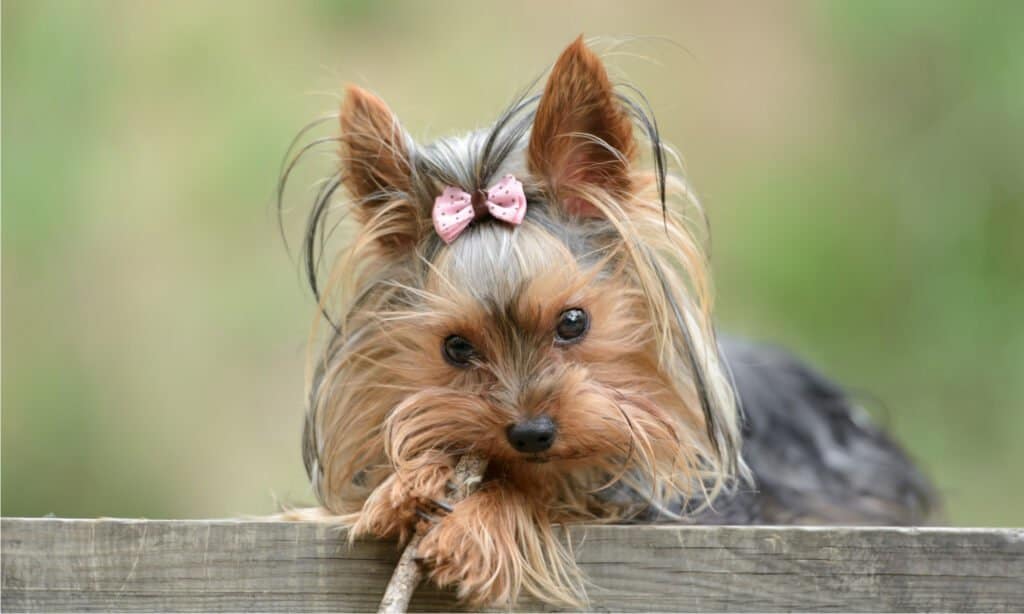
Despite being dainty, Yorkshire
terriers
are known for being feisty and bold.
©tsik/Shutterstock.com
Fondly called Yorkies, Yorkshire Terriers originated from England and are known for being active, playful, and bold. Due to their big personalities, this small toy dog breed is often accused of having ‘’little dog syndrome,” thinking they are much larger than they actually are. However, they are very small and usually weigh between 4 and 7 pounds.
With their single coat of long and silky hair, it’s easy to see why Yorkies are a delight and can be seen everywhere. Yorkies are reputed to be low-shed dogs, but they require a good amount of maintenance due to their silky, constantly growing hair. If the coat is kept long, it should be brushed every day to avoid tangles and matting. The hair on the dog’s head should either be clipped short or put in a hairband to prevent eye infections.
In case you were wondering, trimming Yorkies is perfectly fine as well. This explains why most Yorkies you encounter have shorter, groomed coats. Yorkies with either long or short hair should always be kept warm in the winter with sweaters or jackets because their coats are just single layers.
A weekly or biweekly bath is a good idea, and you should examine your dog’s ears for dirt and debris at least once each week. Depending on how much your dog breaks its nails, nail trimming will be required around every month. Brushing their teeth ought to be done daily.
#3 Shih Tzu
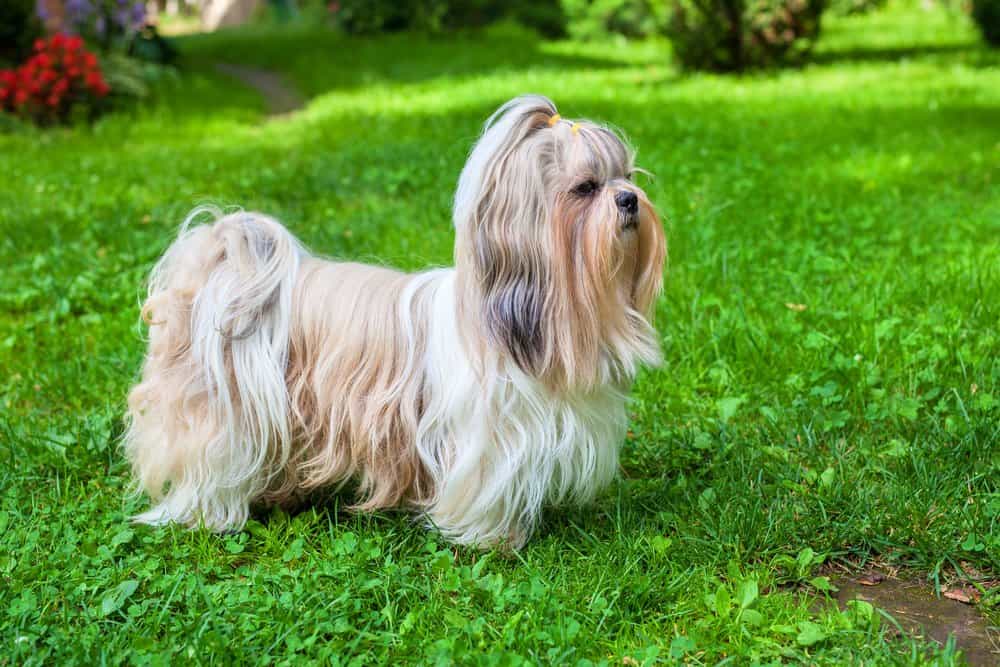
Shih Tzus were originally bred by Chinese royalty.
©chaoss/Shutterstock.com
This is another small toy dog breed. The popular Shih Tzu is a double-coated dog breed recognized for its adorable appearances and vivacious temperament. Thanks to its pushed-in face and long, flowing coat, this breed is known as the “lion dog” in Chinese.
Shih Tzus are of Tibetan descent and are reputed to have been a favorite of Chinese royalty. It’s no wonder that they would prefer to spend the entire day in your lap. Shih Tzus, while they can be loving, energetic, and outgoing home pets, are also one of the most common brachycephalic dog breeds, making them prone to breathing difficulties.
This breed is widely regarded as a hypoallergenic dog breed because of its continuously growing coat and very little shedding. However, it’s a good idea to spend some time with a Shih Tzu to see if this breed causes you any allergies.
Due to their coat type, Shih Tzus absolutely need routine maintenance. While some Shih Tzu owners decide to trim the hair for a curled or fluffy appearance, others prefer to keep their coats long. If you opt for the former, brushing your dog once or twice a week is sufficient, and it should be once a day if you go with the latter.
Some Shih Tzus may don a topknot or a bow to prevent the facial hair from irritating the eyes.
#4 Collie
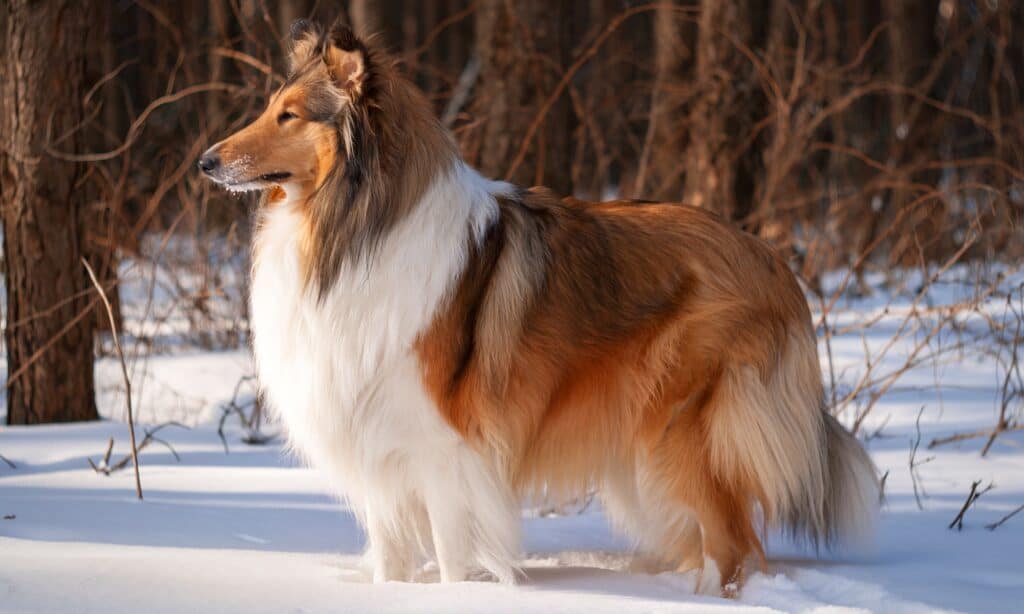
Collie dogs are champion
herding dogs
.
©iStock.com/Eugenegg
Collies are some of the most popular of the longest-haired dog breeds and can have either a rough or smooth coat. Defining features such as long, fluffy coats and Lassie-like colors, are what make the rough-coated Collie an easily recognized breed. A rough Collie needs a little more brushing than a smooth, short-hair collie, to keep it free of tangles. This should be done at least a couple of times per week. Smooth Collies can be brushed once every week.
As mats are usually found hiding in the thick fur, ensure you check the entire coat thoroughly. Once or twice a year, you may also anticipate periods of increased shedding during which you’ll need to brush both breeds more regularly. Bath your collie once a month, or more frequently if it gets soiled.
#5 Havanese

Havanese puppies have curly hair, while adults have wavy or straight hair and weigh between 7-13 pounds.
©Dorottya Mathe/Shutterstock.com
Named after the capital city of the island nation of Cuba, this double-coated toy dog breed earned the title “National Dog of Cuba.” Havanese are well-liked family dogs due to their levels of intelligence, affection, and socialization. They exist in a range of colors and are sometimes mistaken for Maltese or Shih Tzus.
At least once or twice per week, give your dog a good brushing. If you keep your Havanese’s hair long, its thick coat requires daily brushing to prevent tangles and mats. Although it requires a lot of maintenance to achieve, this breed also looks amazing with cords.
Since many Havanese owners like to keep their dogs’ coats short, trimmings may be required every few weeks. They thrive in hot conditions because of their coat, which shields them from the sun. Given that they can withstand cold temperatures to a certain extent, it is advisable to leave the coat longer in the winter.
#6 Irish Setter
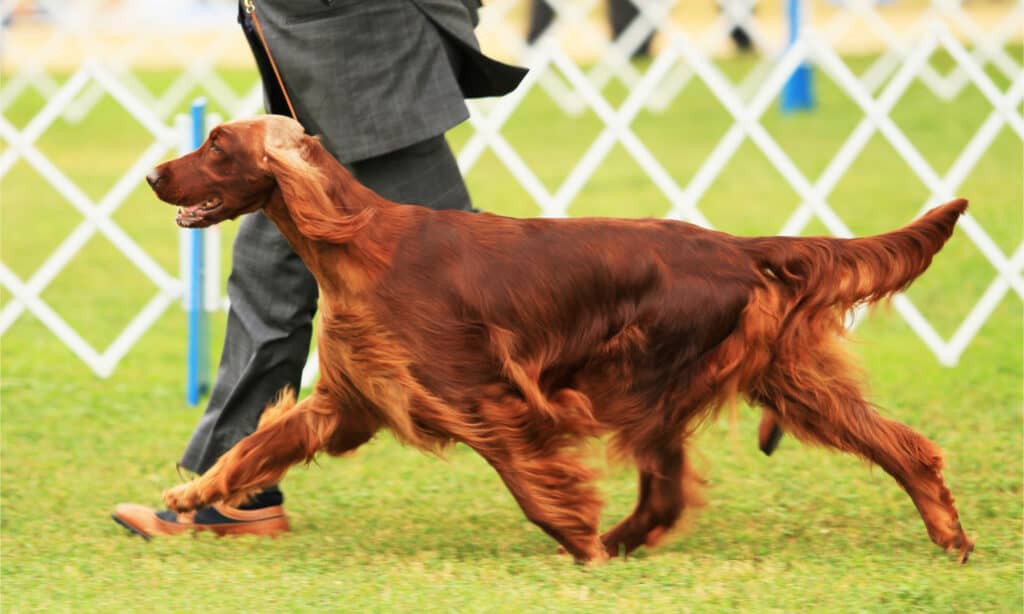
The Irish Setter is a graceful hunting dog.
©Canden Scales/Shutterstock.com
This medium-sized dog breed was originally known as the Irish Red Setter when it was used for hunting. The Irish Setter appears to have originated from Ireland in the 18th century and was most likely created by crossing Gordon Setters, English Setters, and spaniels. With its unique mahogany color and athleticism, the Irish Setter has gained popularity as a bird dog.
Weekly brushing is recommended for Irish Setters. Since their silky hair tangles so quickly, these dogs are in need of combs and detangling gear, especially because a large portion of their long hair is found on their legs and underbelly.
When kept as family pets, Irish Setters can have their hair cut slightly shorter than show dogs, who surely have straighter, longer coats.
#7 Komondor
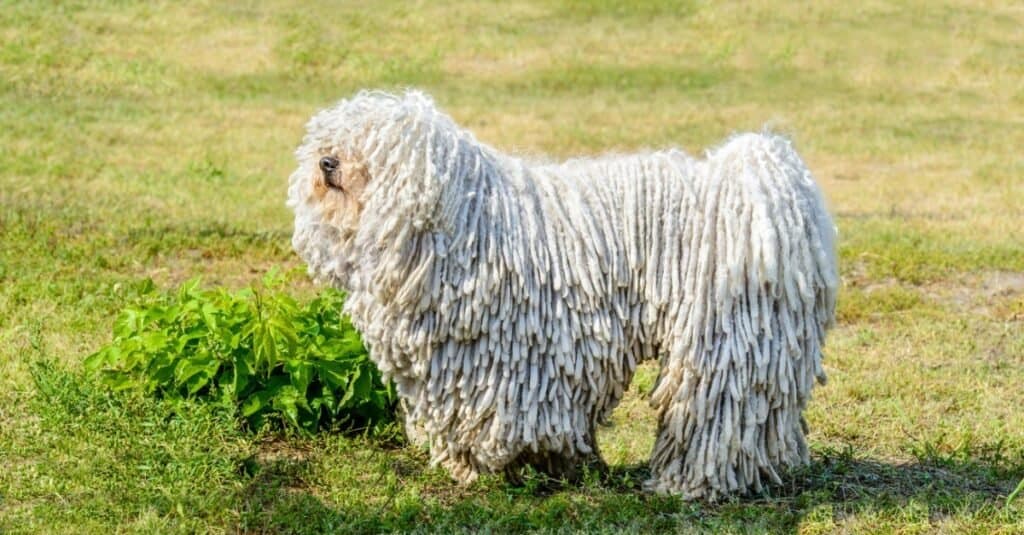
Komondor puppies have a white, soft, and fluffy coat that changes between 12-24 months. Then the coat will become matted.
©iStock.com/volofin
One of the most unique longest-haired dog breeds is the Komondor. The Komondor is referred to as the “Hungarian sheepdog” because its white corded hair serves as camouflage, making it difficult for predators to see. The coat is soft and wavy when it is a puppy. As a Komondor ages, the outer coat becomes rougher and traps the softer undercoat, resulting in cords. These locks offer warmth and shelter from the weather while defending the dog from vicious predators pursuing the flock.
Fancy this breed? There are things to note as a potential Komondor owner. As you might have guessed, you must adhere to a regimented grooming schedule to keep your pet healthy and looking good. It is recommended for you to wash their corded hair instead of brushing it. Just make sure to properly rinse the cords to remove all traces of shampoo before patting them dry with towels.
#8 Newfoundland
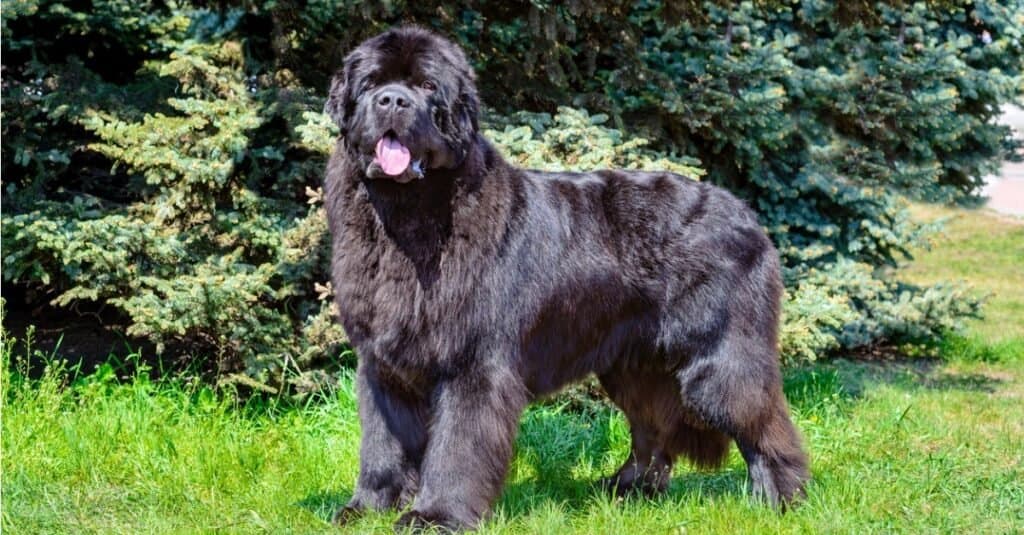
Newfoundlands are capable, hardworking dogs, and well suited to work on land or water.
©iStock.com/volofin
Newfoundlands are recognized for having a gentle temperament and being good with kids. They are also large dogs and can weigh up to 150 pounds.
When it comes to grooming, you need a slicker brush and comb to clean their thick coats. Heads up! Newfoundlands shed a lot and have multilayered coats that can mat easily. Do well to move steadily and ensure you don’t miss any areas on the large dog’s body.
#9 Puli

Puli dogs have long hair that forms into tight curls and waterproof cords.
©iStock.com/Bigandt_Photography
Like its cousin the Komondor, the white, black, or grey-colored Puli originated from Hungary. However, it has thinner cords that resemble ropes and develop spontaneously as the outer and inner coats entwine.
Pulis’ double-coated, curly fur is prone to tangling because of its curly nature. Similar to other corded dogs, they can be bathed but must be completely cleaned and dried, which can take some time.
To keep its cords tidy, clean, and appealing, the Puli’s coat requires intensive care. Over time, the ropes may reach the ground. This breed’s fur can be cut short, although doing so takes away from its unusual appearance.
#10 Maltese
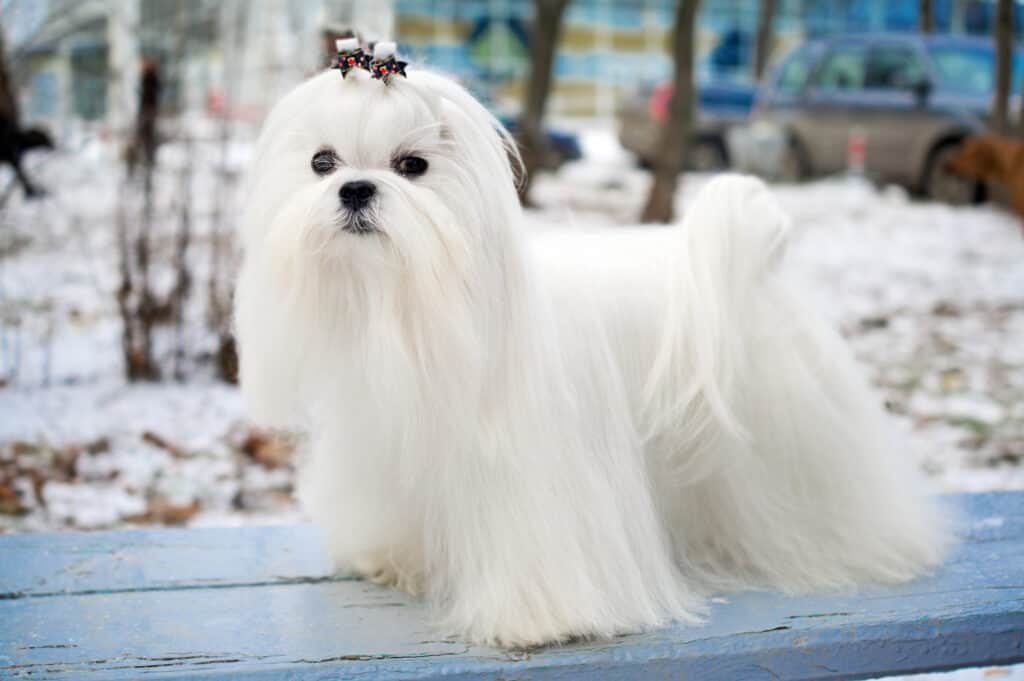
Maltese are noble dogs with affectionate and lively personalities.
©iStock.com/Laures
Maltese are excellent miniature watchdogs, a trait that can be traced back to the breed’s history. The single-layer coat of a Maltese can be styled in a variety of ways, including long on the head and tail and short hair on the body, all short, or long hair that touches the ground. Given that long coats can be difficult to maintain, the majority of owners choose short coats.
Other aspects of routine grooming such as nail trimming, weekly to monthly baths, and dental hygiene should be done as necessary.
Up Next…
Take a look at a few of our other dog-related articles.
- 6 Fluffiest Dog Breeds – If you want a fluffy furball, this list is what you’re looking for.
- 10 Strangest Dog Breeds – Funny looking dogs more your thing? Check out our list of the weirdest ones.
- 9 Teacup Dog Breeds – Read on if tiny toy dog breeds are what you want.
The photo featured at the top of this post is © DragoNika/Shutterstock.com
Ready to discover the top 10 cutest dog breeds in the entire world?
How about the fastest dogs, the largest dogs and those that are -- quite frankly -- just the kindest dogs on the planet? Each day, AZ Animals sends out lists just like this to our thousands of email subscribers. And the best part? It's FREE. Join today by entering your email below.
Sources
- Pet Keen / Accessed August 4, 2022
- The Spruce Pets / Accessed August 4, 2022
FAQs (Frequently Asked Questions)
Do long-haired dogs shed?
Dogs of all breeds, even those with lengthy hair, tend to shed. However, the quantity that a dog sheds varies greatly between breeds. Some long-haired dog breeds, such the Yorkshire Terrier and Portuguese Water Dog, actually shed relatively little. Others, like the Great Pyrenees and Alaskan Malamute, shed a lot because of their dense double coats. Regardless, all long-haired dogs should be brushed and groomed on a regular basis to remove dead or damaged hair and maintain healthy skin.
Are long-haired dogs hypoallergenic?
No dog is absolutely hypoallergenic, although those that are usually referred to as such do produce less saliva, dander, and hair, which may lessen their impact on people who have mild to moderate dog allergies.
Thank you for reading! Have some feedback for us? Contact the AZ Animals editorial team.







